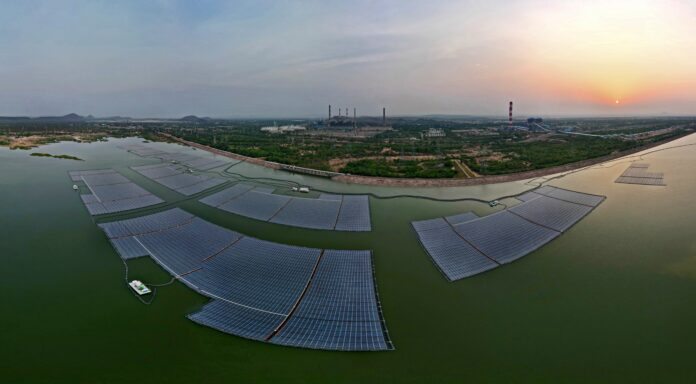The final part capacity of 20 MW out of 100 MW Ramagundam Floating Solar PV Project at Ramagundam, Telangana was declared Commercial Operation with effect from 00:00 hours of July 01, 2022. With this, the 100 MW Floating Solar Power Project is fully operational and is now the Largest in the segment in the country.
On achieving the milestone, Regional Executive Director (South) Shri Naresh Anand congratulated Team Ramagundam and reiterated NTPC’s commitment for Renewable Energy. Shri Anand further added that Southern Region is augmenting NTPC’s Renewable Energy capacity addition target. With the operational of 100-MW Solar PV Project at Ramagundam, total commercial operation of Floating Solar Capacity in Southern Region rose to 217 MW. Earlier, NTPC declared Commercial operation of 92 MW Floating Solar at Kayamkulam (Kerala) and 25 MW Floating Solar at Simhadri (Andhra Pradesh), Shri Anand added.
Largest in the segment in the country, the 100-MW Floating Solar project at Ramagundam is endowed with advance technology as well as environment friendly features. Constructed with financial implication of Rs. 423 crores through M/s BHEL as EPC (Engineering, Procurement and Construction) contract, the project spreads over 500 acres of its reservoir. Divided into 40 blocks, each having 2.5 MW. Each block consists of one floating platform and an array of 11,200 solar modules. The floating platform consists of one Inverter, Transformer, and a HT breaker. The solar modules are placed on floaters manufactured with HDPE (High Density Polyethylene) material.
The entire floating system is being anchored through special HMPE (High Modulus Polyethylene) rope to the dead weights placed in the balancing reservoir bed. The power is being evacuated up to the existing switch yard through 33KV underground cables. This project is unique in the sense that all the electrical equipment including inverter, transformer, HT panel and SCADA (supervisory control and data acquisition) are also on floating ferro cement platforms. The anchoring of this system is bottom anchoring through dead weight concrete blocks.
From environment point of view, the most obvious advantage is minimum land requirement mostly for associated evacuation arrangements. Further, with the presence of floating solar panels, the evaporation rate from water bodies is reduced, thus helping in water conservation. Approximately 32.5 lakh cubic meters per year water evaporation can be avoided. The water body underneath the solar modules helps in maintaining their ambient temperature, thereby improving their efficiency and generation. Similarly, while Coal consumption can be avoided of 1,65,000 Tons per year; Co2 of 2,10,000 tons per year can be avoided.

